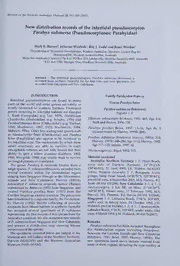
NEW DISTRIBUTION RECORDS OF THE INTERTIDAL PSEUDOSCORPION PARAHYA SUBMERSA (PSEUDOSCORPIONES PARAHYIDAE) PDF
Preview NEW DISTRIBUTION RECORDS OF THE INTERTIDAL PSEUDOSCORPION PARAHYA SUBMERSA (PSEUDOSCORPIONES PARAHYIDAE)
Recordsofthe WesternAustralianMuseum23:393-395 (2007). New distribution records of the intertidal pseudoscorpion Parahya submersa (Pseudoscorpiones: Parahyidae) MarkS.Harvey’,JulianneWaldock’,Roy Teale^andJenniWebber’ J. ’DepartmentofTerrestrialInvertebrates,WesternAustralianMuseum,LockedBag49, WelshpoolDC,WesternAustralia6986,Australia ^BiotaEnvironmentalSciencesPtyLtd,POBox155,Leederville,WesternAustralia6903,Australia ’P.O.Box2280,HumptyDoo,NorthernTerritory0836,Australia Abstract - The intertidal pseudoscorpion Parahya submersa (Bristowe) is recorded from northern Australia for the first time, and new specimens are recordedfromSingaporeandNewCaledonia. INTRODUCTION FamilyParahyidaeHarvey Intertidal pseudoscorpions are found in many GenusParahyaBeier parts of the world and some genera are totally or mostly restricted to seashore habitats. Prominent Parahyasubmersa(Bristowe) genera occurringin intertidal habitats are Garypus Figures1,2 L. Koch (Garypidae) (e.g. Lee, 1979), Halobisium Chamberlin (Neobisiidae) (e.g. Schulte, 1976) and Obisium submersum Bristowe, 1931; 465, figs 3-6; Paraliocbthonius Beier (Chthoniidae) (e.g. Vachon, RothandBrown,1976; 128. 1960; Muchmore, 1967, 1972; Muchmore, 1984; Parahya pacifica Beier, 1957: 15-16, figs 4b, 5 Mahnert, 1986). Other lesswidespread generasuch (synonymisedbyHarvey, 1991b:288). as NannocheliferBeier (Cheliferidae) and Parahya Beier (Parahyidae) also appear to be restricted to Parahya submersa (Bristowe): Harvey, 1991a: 315; theintertidalzone.Themechanismsbywhichthese Harvey, 1991b:288-290, figs 1-12;Harvey, 1992: small arachnids are able to survive in such figs 117-125;Judson, 1997:42. inhospitable habitats are not fully known but their Microcreagrissp.:Bigot, 1992: 113. ability to spin a silken chamber (Gabbutt, 1962, 1966; Weygoldt, 1969) may enable them to survive Material examined prolongedperiodsofinundation. Australia: Northern Territory:1 $, PlaterBeach, The genus Parahya is currently known from a west side of Darwin Harbour, 12°29.25'S, singlespecies,P.submersa(Bristowe),recordedfrom 130°46.55'E, 21 April 1999, J.K. Webber (MAGNT several locations within the Australasian region A951); Western Australia: 1 $, Bonaparte Archi- ranging from Singapore through to theMicronesian pelago, Steep Head Island, 14°26'52"S, 125°59'44"E, islands and New Caledonia. Harvey (1991b) intertidalzone,6September2002, M.S. Harvey, R.J. redescribed P. submersa, originally named Obisium Teale (WAM T57298). New Caledonia: 3 d, 4 5, 3 submersumbyBristowe (1931) fromSingapore, and deutonymphs, 5 km SE. of Mou, 21°06’30"S, treated Parahya pacifica Beier (1957) from the 165°27'30"E, littoral zone, 11 February 1993, M.S. CarolineIslandsasajuniorsynonym.Thegenuswas Harvey, N.I. Platnick, R.J. Raven (WAM T62568). latertransferredtoaseparatefamily,theParahyidae, Singapore: 1 3, Labrador Beach, 1°16'N, 103°48'E, by Harvey (1992). Recent collecting of pseudo- under rock in littoral zone, 24 October 1992, J.M. scorpionsfromlittoralhabitatsinnorthernAustralia Waldock (WAMT62566); 5 d, 8 9,1 deutonymph, has revealed several specimens of P. submersa LabradorBeach,1°16'N, 103“48'E,underrocks,tidal representingthefirstrecordsofthisspeciesfromthe zone,8March1994,J.M.Waldock(WAMT62567). Australiancontinent.Wealsodocumentnewrecords ofP. submersafrom Singaporeand NewCaledonia, Remarks and present a distribution map showing known Parahyasubmersahasbeen recorded throughout occurrencesofthespecies. the Australasian region including Singapore, The specimens recorded below are lodged in the Sulawesi, the Caroline Islands and New Caledonia Museumand ArtGalleryoftheNorthernTerritory, (Bristowe, 1931; Beier, 1957; Harvey, 1991b). The Darwin (MAGNT) and the Western Australian new specimens listed above include material from Museum,Perth(WAM). some oftheseregions includingthetype locality of 394 M.S.Harvey,J.Waldock,R.J.Teale,J.Webber Obisium submersum, Singapore, and New Caledonia.TheAustralianrecordsrepresentaslight range extension, indicating that P. submersa has a wider distribution in the Australasian region than previously recognised. The record ofMicrocreagris sp. from Recif Croissant, New Caledonia by Bigot (1992) appears to be based upon the same specimens identified by Harvey (1991b) as P. submersa. AH specimens of P. submersa reported to date (Bristowe, 1931; Beier, 1957; Harvey, 1991b) are fromlittoralhabitatssuggestingthatitisanobligate littoral species. The following habitats have been noted on locality labels accompanying specimens: "beach, sea" and "beneath boulders on seaward reef" (Caroline Islands); "dans la zone superieure de Testran (zone a gros chiton)" and "levee detritique de madrepores" (New Caledonia); "underrocksonsand,halfwaydown littoralzone" (Singapore);and "belowlogonmud ataroundmid- tide level in mangrove" (Sulawesi). The new records are from similar habitats. The specimens from Steep Head Island, Western Australia, were found on theundersideofrocks thatwereexposed on the beach at low tide, but which were fully covered at high tide. They occurred amongst polychaete tubes and other intertidal marine invertebrates, butno traceofa silken chamber was observed. The specimens ran backwards quickly whendisturbed. Figure1 Parahya submersa (Bristowe), female from Steep Head Island, Western Australia (WAM T62566). Figure2 MapofAustralasiashowingknowndistributionofParahyasubmersa(Bristowe). IntertidalpseudoscorpionParahyasubmeisa 395 ACKNOWLEDGEMENTS Judson, M.L.I. (1997). Catalogue of the pseudoscorpion MSH wishes to thank Norman Platnick and types (Arachnida: Chelonethi) intheNaturalHistory Robert Raven for facilitating the trip to New Museum, London. Occasional Papers on Systematic Caledonia, Gavin Dally for the loan of material Entomology11:1-54. fromtheMAGNT, andRicHowwhofacilitated the Lee, V.F. (1979). The maritime pseudoscorpions of Baja WtreipatroetghreatKefiumlbetorltewyoraengoinonymoofuWsesretfeerrneeAsufsotrratlhieai.r SCOacclicieafnsocrienosina1a,3l1:MPeiax-piivec,ro1s-(3o8Af.ratchhenidCaa:lifPosrenuidaosAcocrapdioenmiyda)o.f commentsonadraftofthemanuscript. Mahnert, V. (1986). Die Pseudoskorpione (Arachnida) Kenyas. VIII. Chthoniidae. RevueSuissedeZoologie 92: 823-843. REFERENCES Muchmore, W.B. (1967). Two new species of the Beier, M. (1957). Pseudoscorpionida. Insects of pseudoscorpion genus Faraliochthonius. Entomol- Micronesia3; 1-64. ogicalNews78:155-162. Bigot, L. (1992). Contribution a I'etude des peuplements Muchmore, W.B. (1972). The pseudoscorpion genus littorauxetcotiersdelaNouvelle-Caledonie(Grande Paraliochthonius (Arachnida, Pseudoscorpionida, Terre, He des Pins) et d'une ile Loyaute (Ouvea): Chthoniidae).EntomologicalNews83:248-256. deuxieme inventaire desArthropodes. Annalesdela Muchmore, W.B. (1984). Pseudoscorpions from Florida SocieteEntomologique deFrance, nouvelleseries28: and the Caribbean area. 13. New species of 113-123. Tyrannochthonius and Paraliochthonius from the Bristowe, W.S. (1931). Notes on the biology of spiders. Bahamas, with discussion of the genera (Chthon- IV. Further notes on aquatic spiders, with a iidae).FloridaEntomologist67:119-126. descriptionofanewspeciesofpseudoscorpion from Roth, V.D. and Brown, W.L. (1976). Other intertidal air- Singapore. AnnalsandMagazine ofNaturalHistory breathing arthropods. In Cheng, L. (ed.). Marine (10)8:457-465. insects: 119-150. North-Holland Publishing Co.: Gabbutt,P.D.(1962).'Nests'ofthemarinefalse-scorpion. AmsterdamandOxford. Nature196:87-88. Schulte, G. (1976). Litoralzonierung von Gabbutt, P.D. (1966). An investigation of the silken Pseudoskorpionen an der nordamerikanischen chambers of the marine pseudoscorpion Neobisium Pazifikkiiste (Arachnida: Pseudoscorpiones: Neobis- maritimum.JournalofZoology,London149:337-343. iidae, Garypidae). Entomologica Germanica 3: 119- Harvey, M.S. (1991a). Catalogue of the Pseudo- 124. scorpionida. Manchester University Press: Vachon,M. (1960).Surunenouvelleespecehalophilede Manchester. Pseudoscorpions de I'Archipel de Madere: Harvey,M.S. (1991b). NotesonthegeneraParahyaBeier Paraliochthoniushoestlandti(Fam. desChthoniidae). andStenohyaBeier(Pseudoscorpionida:Neobisiidae). Bulletin du Museum National d'Histoire Naturelle, Bulletin oftheBritish ArachnologicalSociety8: 288- Paris(2)32:331-337. 292. Weygoldt, P. (1969). The biology ofpseudoscorpions. Harvey, M.S. (1992). Thephylogeny and classificationof HarvardUniversityPress:Cambridge,Massachusetts. the Pseudoscorpionida (Chelicerata: Arachnida). InvertebrateTaxonomy6:1373-1435. Manuscriptreceived10July2006;accepted30August2006
